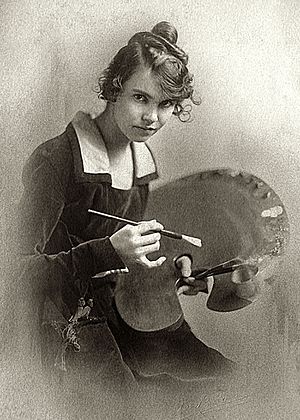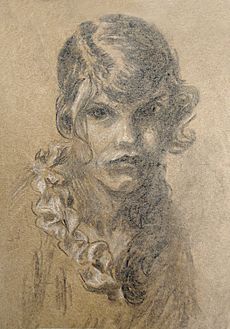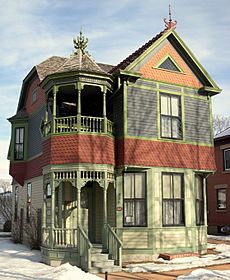Wanda Gág facts for kids
Quick facts for kids
Wanda Hazel Gág
|
|
|---|---|

Gág in December 1916
|
|
| Born | March 11, 1893 New Ulm, Minnesota, United States |
| Died | June 27, 1946 (aged 53) New York, New York |
| Occupation | Artist, writer, translator |
| Nationality | American |
| Genre | Children's literature |
| Notable works | Millions of Cats |
| Notable awards | Newbery Honor, Caldecott Honor |
Wanda Hazel Gág (born March 11, 1893 – died June 27, 1946) was an American artist, writer, and illustrator. She is famous for writing and illustrating the children's book Millions of Cats. This book is the oldest American picture book that is still being printed today! Wanda Gág was also known for making amazing prints, which are artworks created by pressing ink onto paper. She won many awards for her art. Her book Growing Pains, which shared parts of her teenage diaries, was also very popular. Two of her books won Newbery Honor awards, and two others received Caldecott Honor awards.
Contents
Early Life and Dreams
Wanda Gág was born on March 11, 1893, in New Ulm, Minnesota. Her family spoke German. Her parents were Elisabeth Biebl Gag and Anton Gag, who was an artist and photographer. Wanda was the oldest of seven children.
When Wanda was 15, her father passed away. His last words to her were: "What Papa couldn't do, Wanda will have to finish." This meant he wanted her to continue his artistic dreams. After her father's death, her family faced tough times. Some people in town thought Wanda should stop high school and get a job to help her family. But Wanda kept going to school.
Even as a teenager, her illustrated story Robby Bobby in Mother Goose Land was published in a newspaper! After finishing high school in 1912, she taught at a country school for a short time.
Learning to Be an Artist
In 1913, Wanda met Edgar T. Herrmann, a university student who introduced her to new ideas about art and life. With help from a scholarship and friends, she went to art school in Saint Paul from 1913 to 1914. Then, from 1914 to 1917, she studied at The Minneapolis School of Art. There, she became friends with other artists like Harry Gottlieb.
Her first job illustrating a book was for A Child’s Book of Folk-Lore— Mechanics of Written English in 1917.
Moving to New York City
In 1917, Wanda won a scholarship to a famous art school in New York City called the Art Students League of New York. She learned about drawing, etching, and advertising art. By 1919, she was working as a commercial illustrator, drawing pictures for businesses.
In 1923, Wanda had her first art show all by herself at the New York Public Library. Around this time, she started signing her artworks simply as "Gág."
Her art was shown in many places. In 1926, she had a show at the Weyhe Gallery. People called her "one of America’s most promising young graphic artists." She sold many of her prints, watercolors, and drawings through this gallery.
Wanda's work was also shown in big art exhibitions, like Art in Our Time at The Museum of Modern Art in 1939. During the COVID-19 pandemic in 2020, the Philadelphia Museum of Art showed her unique drawings made on sandpaper. She used sandpaper to give her art a special sparkly and rough look!
Creating Books for Children
In 1927, Wanda's story Bunny's Easter Egg was published in a children's magazine. Her work caught the eye of Ernestine Evans, who worked for a children's book publisher. Ernestine loved Wanda's ideas and asked her to create her own story with illustrations.
This led to Millions of Cats, which was published in 1928. Wanda had actually made up this story to entertain her friends' children. The book became an instant hit! One reviewer said it would be a "perennial favorite among children" because of its original pictures and folk-tale feel. Millions of Cats is even on the New York Public Library's list of 100 Great Children's Books.
In 1935, she published Gone is Gone; or, the Story of a Man Who Wanted to Do Housework, a story about a man who tries to do all the housework.
Wanda also loved fairy tales. To help more children enjoy them, she translated and illustrated Tales from Grimm in 1936. People praised her translations for being clear and easy to understand. Two years later, she translated and illustrated the Grimm story Snow White and the Seven Dwarfs. She wanted to share the original story, not the "trivialized" movie version. She even wrote an essay called "I Like Fairy Tales." Her book More Tales from Grimm was published after she passed away.
Personal Life
Wanda Gág loved living and working in the countryside. She bought a farm in Milford, New Jersey, in 1931, which she called “All Creation.”
She continued to support her brothers and sisters, and some of them lived with her. Her brother Howard helped with the lettering for most of her picture books. She also encouraged her sister Flavia to create illustrated books for children.
Wanda married Earle Humphreys on August 27, 1943. She passed away from lung cancer in New York City on June 27, 1946.
Wanda Gág's Legacy
Wanda Gág is seen as a pioneer in how picture books are made. Before Millions of Cats, most illustrated books had text on one page and pictures on the next. Wanda changed this by combining the text with the pictures, often spreading them across two pages. This made her books more exciting and flowing.
Artists She Inspired
Many artists have been inspired by Wanda Gág's work. Some of them include Eric Rohmann, Ursula Dubosarsky, Susan Marie Swanson, Jan Brett, and Maurice Sendak.
Remembering Wanda Gág
Wanda Gág's childhood home in New Ulm, Minnesota, has been made into a museum called the Wanda Gág House. You can visit it and learn about her life and work. In 1992, Millions of Cats was featured on the TV show Shelley Duvall's Bedtime Stories, with James Earl Jones narrating.
In 2016, a bronze statue of Wanda Gág with one of her cats was placed at the public library in New Ulm. In 2017, a play about her childhood, called In The Treetops, was performed in Minneapolis.
Awards and Honors
Wanda Gág's books received many awards:
- Millions of Cats and The ABC Bunny both won a Newbery Honor.
- Snow White and the Seven Dwarfs and Nothing at All both received a Caldecott Honor.
- She was honored with The Lewis Carroll Shelf Award in 1958 and The Kerlan Award in 1977.
- The University of Minnesota, Moorhead, gives out The Wanda Gág Read Aloud Book Award every year.
- In 2018, she received the Original Art Lifetime Achievement Award from the Museum of Illustration.
Where Her Art Is Kept
Wanda Gág's prints, drawings, and watercolors are kept in many famous museums around the world. These include The National Gallery of Art, the British Museum, and The Minneapolis Institute of Art. Her papers and original writings are also kept in special collections at places like the University of Minnesota and The New York Public Library.
Wanda Gág's Books
Books She Wrote and Illustrated
- Batiking at Home: a Handbook for Beginners, 1926
- Millions of Cats, 1928
- The Funny Thing, 1929
- Snippy and Snappy, 1931
- Wanda Gág’s Storybook (includes Millions of Cats, The Funny Thing, Snippy and Snappy), 1932
- The ABC Bunny, 1933
- Gone is Gone; or, the Story of a Man Who Wanted to Do Housework, 1935
- Growing Pains: Diaries and Drawings for the Years 1908-1917, 1940
- Nothing At All, 1941
Books She Translated and Illustrated
- Tales from Grimm, 1936
- Snow White and the Seven Dwarfs, 1938
- Three Gay Tales from Grimm, 1943
- More Tales from Grimm, 1947
Books She Only Illustrated
- A Child’s Book of Folk-Lore— Mechanics of Written English, by Jean Sherwood Rankin, 1917
- The Oak by the Waters of Rowan, by Spencer Kellogg Jr, 1927
- The Day of Doom, by Michael Wigglesworth, 1929
- Pond Image and Other Poems, by Johan Egilsrud, 1943
Books She Only Translated
- The Six Swans, illustrations by Margot Tomes, 1974
- Wanda Gág's Jorinda and Joringel, illustrations by Margot Tomes, 1978
- Wanda Gag's the Sorcerer's Apprentice illustrations by Margot Tomes, 1979
- Wanda Gag's The Earth Gnome, illustrations by Margot Tomes, 1985
Images for kids







